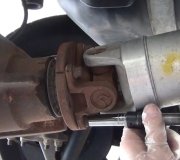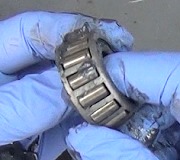If this is engine-related, look at the engine speed this occurs at, then down-shift one gear and see if the same vibration is felt at the same rpm, but lower road speed. If it is, the only good suspect is a worn torque converter bushing. I've only seen this once. The vibration, (shudder), was much faster than an out-of-balance tire vibration, and pulsed on and off about every two to three seconds.
Where are you feeling this vibration? If it's in the steering wheel, we have to concentrate on the front. If you feel it in the seat or floor, the cause is more likely in the rear. An elusive cause is a brake that is sticking on. One potential clue is you'll feel one wheel is at a higher temperature after a long highway-speed drive. One common cause is a rear parking brake cable that is rusted partially applied, or is sluggish and doesn't like to return under normal spring tension. Look where the cable exits the front of its outer casing. A cable that isn't fully retracted will be shiny for the first half inch or so compared to the normal dirt buildup on the rest of it. If this has just started to be a problem, you'll often get that cable fully retracted by flexing the casing repeatedly.
When this is caused by a sticking front brake, a real good suspect is the rubber flex hose. There's a metal tube crimped around it in the middle as part of a mounting bracket. Rust can build up inside that tube and constrict the hose. You'll be able to push brake fluid through that restriction to apply the brake, but that fluid can't return and gets stuck. That keeps that brake applied and building heat. The heat makes the brake fluid expand and apply that brake even harder. At its worst, it will feel like that tire is bouncing off the ground, and it will severely shake the steering wheel.
Did anything change when you switched the wheels / tires? In your original post you started to say this isn't a wheel balance issue. How do you know that?
When this occurs within such a small window, it suggests something that is slightly out of balance is hitting its "resonant frequency". That's the frequency at which it wants to occur at naturally, like the pendulum on a grandfather's clock. It takes more energy to make it swing faster or slower. Similarly, it takes the least amount of energy to make this vibration occur at the speed you listed. If this is a thumping that occurs once per tire rotation, a real good suspect is a worn rear strut. Same for a shock absorber on vehicles that have them. This is actually rather common to show up only after a really long run. We had one vehicle driven one way for 120 miles, then back again to the dealership by our shuttle van driver. It took that long for the vibration to occur. With the constant bouncing down the road, the oil inside the shock absorber heats up a lot and becomes thinner. That lets it pass through the orifices easier so the damping action is lost. At just the right speed a tire would start to bounce at its resonant frequency, and road forces put more energy into that bounce to keep it going, just like adding a little energy to keep a basketball bouncing at its natural frequency. This won't show up right away unless the oil has leaked out of that strut or shock absorber. If this just started leaking recently, you'll see the oil or wetness on the bottom of the strut. If it leaked out some time ago, you'll find mud there instead from road dirt settling and collecting on that oil.
The next thing to look at is the tire wear patterns. Specifically, this can be caused by "total toe" that is out of adjustment. If only one wheel is out of adjustment, the steering wheel will be off-center when driving straight ahead. It's possible for both wheels on one axle to be off an equal amount which keeps the steering wheel straight, but the two values together, (total toe), will make those two tires walk away from or toward the center of the car. The sidewalls can only flex just so much before the tread has to slide across the road and come back, then it starts walking to one side again. That sudden sliding back can be felt as a vibration, but the clue here is it does not have to occur once per tire revolution. This is a factor of how far total toe is off, and the stiffness of the sidewalls.
When looking at tire wear, I have to start with "camber" wear. That's the inward or outward tilt of the wheel as viewed from in front or in back of the vehicle. If a wheel is tipped too much, that one tire will have excessive wear on one edge of the tread. Each tire is affected only by its own adjustment, although it is possible for each one to be out of specs. Total toe always affects both tires equally, even when just one is out of adjustment. An alignment specialist can look at the direction of the wear patterns and tell right away which way total toe is out of specs.
The last thing to consider, especially with the age of the vehicle, is weak or sagged coil springs. This is the same issue that commonly occurs to cars that have been lowered, and trucks that have been raised. The first issue is the arcs, or motions the control arms go through are changed and can be less prone to having oscillations or bouncing dampened out by the struts or shock absorbers. It can also put those suspension parts into orientations that make it harder to control that bouncing. The more easily identifiable concern has to do with driveshaft angle. That refers to the angle difference between the driveshaft itself and the stub shaft stuffed into the back of the transmission, and between the pinion gear in the differential. That angle was very carefully designed in specifically to reduce driveline vibration. The worst angle is when it is perfectly straight, or 0 degrees. That stops the needle bearings from rotating back and forth in the u-joint's bearing cups. All the hammering takes place in one spot, leading to developing ridges inside those cups. Then, as the vehicle bounces up and down, the bearings ride into and out of those ridges creating a humming sound that changes while driving as the vehicle bounces.
Ford had a big problem with this issue in the 1980s. Their Escorts were found to have been lashed down so tightly on the haulers that the coil springs were weakened. They had all kinds of vibration complaints that were solved with new coil springs. With the added weight on their full-size conversion vans, a driveline vibration occurred when they were roughly six months old. It took a pair of rear overload springs to restore chassis ride height and stop that annoying vibration. Dodge also had a problem with some larger trucks after about six to eight years. Ride height was still okay, so the solution was to replace the one-piece driveshaft with a two-piece and center bearing. When the problem occurred again many years later, the recommended solution was to replace that two-piece driveshaft with a one-piece assembly. In both cases, if the truck was run in gear on a hoist, the vibration could be bad enough to make a soda can walk across the top of the dash.
You'll get a similar driveline vibration from a tight universal joint. One potential, and unexpected clue, is that can make it hard to keep the vehicle going 50 mph. It will also slow down much quicker than normal when letting off the gas. This type of vibration is a much higher-speed humming sensation compared to the thumping of a wheel / tire problem.
There's some more ideas to consider. If you haven't measured the wheels' lateral runout with a dial indicator, think about doing that. American Racing supplied Chrysler with some truck wheels in the '90s that were found to cause an annoying vibration. Any wheel with more than.045" of runout got replaced under warranty. That was way too little to see by eye but a new wheel solved the problem.
Thursday, April 6th, 2023 AT 6:28 PM


